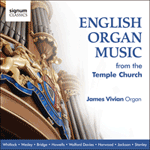Samuel Sebastian Wesley (1810–1876), the outstanding church musician of Victorian England, was successively organist at the cathedrals of Hereford, Exeter, Winchester and Gloucester, and he spent seven years at Leeds Parish Church between the second and third of these appointments.
Choral Song and Fugue, written at Exeter, is the third of his first set of Three Pieces for Chamber Organ, both sets having been written for the organ at Killerton House, Broadclyst, Exeter, the home of Wesley’s pupil Lady Acland, to whom they are dedicated. It comprises a cheerful, tuneful first movement followed by a fugue in which all textbook notions of this daunting form are quickly swept aside: its headlong progress is eventually checked by the arrival of the remote key of C sharp major, and at this point Wesley engineers a return to the home key of C major which has an almost Beethovenian audacity.
from notes by Relf Clark © 2010
Samuel Sebastian Wesley (1810–1876), musicien d’église qui marqua l’Angleterre victorienne, fut successivement organiste de cathédrale à Hereford, Exeter, Winchester et Gloucester; il passa également sept ans à la Leeds Parish Church (entre les deuxième et troisième de ces nominations). Écrit à Exeter, son
Choral Song and Fugue est le troisième morceau des
Three Pieces for Chamber Organ, livre I, le premier de ses deux corpus composés pour l’orgue de Killerton House (Broadclyst, Exeter), la demeure de son élève Lady Acland (à qui ces pages sont dédiées). Ce
Choral Song and Fugue comprend un premier mouvement enjoué, mélodieux, suivi d’une fugue qui balaye d’un coup toutes les notions académiques de cette forme intimidante: sa progression tête la première est finalement enrayée par l’arrivée de la tonalité éloignée d’ut dièse majeur et, à cet instant, Wesley imagine un retour au ton principal d’ut majeur d’une audace quasi beethovénienne.
extrait des notes rédigées par Relf Clark © 2010
Français: Hypérion
Samuel Sebastian Wesley (1810–1876), der herausragende Kirchenmusiker im viktorianischen England, war nacheinander Organist an den Kathedralen von Hereford, Exeter, Winchester und Gloucester und verbrachte sieben Jahre (zwischen Exeter und Winchester) an der Gemeindekirche von Leeds.
Choral Song and Fugue entstand in Exeter als dritter Teil seines
Three Pieces for Chamber Organ, Teil I. Er komponierte beide Teile für die Orgel von Killerton House in Broadclyst, Exeter, dem Heim seiner Schülerin Lady Acland, der das Werk auch gewidmet ist. Es besteht aus einem fröhlichen, melodischen ersten Satz, gefolgt von einer Fuge, die alle Regeln dieses schwierigen Genres in den Wind schlägt. Ihrem überstürzten Fortschreiten wird schließlich Einhalt geboten durch die Ankunft der entfernten Tonart Cis-Dur, und an diesem Punkt meistert Wesley die Rückkehr in die Ausgangstonart C-Dur, die fast Beethovensche Kühnheit hat.
aus dem Begleittext von Relf Clark © 2010
Deutsch: Henning Weber


 English organ music from the Temple Church
English organ music from the Temple Church
